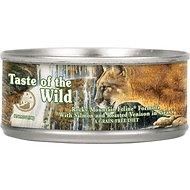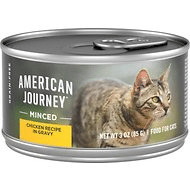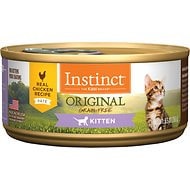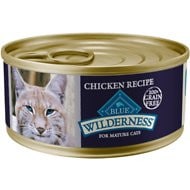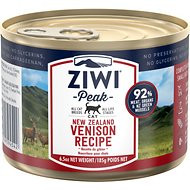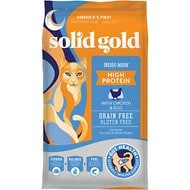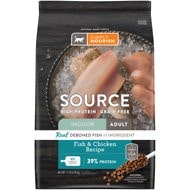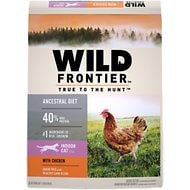Contents
- What Is the Best Food For Bengal Cats?
- History of the Bengal Cat Breed
- Bengal Cat Health and Personality
- What is the Best Cat Food for Bengal Cats?
- How Do We Choose the Best Cat Food?
- The 9 Best Cat Foods for Bengal Cats
- Smalls Ground Bird Human-Grade Fresh Cat Food Service
- Taste of the Wild Rocky Mountain Grain-Free Dry Food
- American Journey Salmon Recipe Grain-Free Dry Food
- Instinct by Nature’s Variety Kitten Grain-Free Real Chicken Recipe Wet Food
- Blue Buffalo Wilderness Mature Chicken Recipe Canned Food
- Ziwi Peak Venison Recipe Canned Cat Food
- 3 More Top Picks for the Best Bengal Cat Food
- Frequently Asked Questions:
The Bengal cat is a lithe, athletic breed and a sight to behold. They are known for their wild appearance, but they are actually quite affectionate with their human families. As beautiful as they are, however, Bengal cats have a lot of energy and they need a lot of activity.
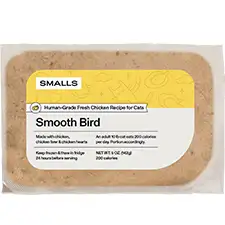
Smalls Human-Grade Ground Bird Fresh Cat Food
- Natural sources of taurine
- High in protein
If you can provide your Bengal cat with plenty of exercise and attention, you’ll find yourself with a playful, loving cat who is always entertaining. To keep your Bengal healthy, however, you’ll also have to provide him with the ideal diet to support his high energy and nutritional needs. Read on to learn the basics about the Bengal breed and to see our top picks for the best Bengal cat food.
What Is the Best Food For Bengal Cats?
- Smalls Ground Bird Human-Grade Fresh Cat Food Service
- Taste of the Wild Rocky Mountain Grain-Free
- American Journey Salmon Recipe Grain-Free
- Instinct by Nature’s Variety Kitten Grain-Free
- Blue Buffalo Wilderness Mature Chicken Recipe
- Ziwi Peak Venison Recipe Canned Cat Food
- Solid Gold Indigo Moon with Chicken & Eggs
- Simply Nourish Source Fish & Chicken Recipe
- Wild Frontier Indoor Adult Open Valley Recipe
History of the Bengal Cat Breed
The Bengal cat breed was born of a crossing between domestic cats and the Asian leopard cat. Jean Mill, a breeder from California, is credited with creating the modern Bengal breed. She made the first deliberate cross between an Asian leopard cat and a domestic cat (a black tomcat from California), though there are mentions of similar crossings that date as far back as 1889. Mill took up her breeding efforts in earnest in the 1970s.
In 1983, the Bengal cat breed was officially accepted by The International Cat Association (TICA) and gained championship status less than a decade later. The Governing Council of the Cat Fancy (GCCF) accepted the breed in 1997 and the Federation Internationale Feline (FIFe) followed suit in 1999. The Cat Fanciers’ Association (CFA) was among the last organizations to accept the Bengal breed. The board accepted the breed in the Miscellaneous category in 2016 but required specimens to be F6 or later (at least 6 generations removed from Asian leopard cat or non-Bengal domestic cat ancestors).
Though the Bengal breed has been around for over a century, its popularity has really spiked over the last few decades. In 1992, The International Cat Association only had 125 registered breeders but, as of 2019, there are now nearly 2,000 Bengal breeders worldwide.
Bengal Cat Health and Personality
The history of the Bengal cat breed brings to mind the modern trend of “designer dogs” where breeders attempt to capture the best of two separate breeds to create the ideal dog. The development of the Bengal cat came from a fascination with the beauty of wild cats. Many have tried and failed to keep smaller wild cats like ocelots as pets, but the Bengal cat was developed as a safer way to meet the desire for a wild-looking cat without sacrificing all of the benefits of a domesticated cat.
As a breed, Bengal cats are extremely intelligent, active, and curious. They are not the best breed for a first-time cat owner or for someone looking for a lap cat. Bengals demand a great deal of interaction and they are easily bored which, as any experienced cat owner knows, only leads to trouble. Every Bengal cat is an individual, but most get along well with dogs and they can do well in homes with older children. The biggest thing to remember about Bengal cats is that they love to climb, so they need a lot of vertical territory in the home to keep them occupied.
When it comes to the health of Bengal cats, there are several issues to be concerned with:
- Distal Neuropathy – A nervous system disorder that can develop as early as 1 year and causes weakness in the legs.
- Flat-Chested Kitten Syndrome – A physical deformity that ranges in severity but usually doesn’t cause issues if the kitten survives to adulthood.
- Hypertrophic Cardiomyopathy – A heritable form of heart disease.
- Hip Dysplasia – A malformation of the hip joint that may cause the hip to pop in and out of socket, often leading to lameness in severe cases.
- Patellar Luxation – A hereditary dislocation of the patella (kneecap) that can lead to early arthritis and may be corrected with surgery.
- Progressive Retinal Atrophy – A degenerative eye disease that is usually inherited.
The key to keeping any cat healthy is to ensure that your cat gets proper veterinary care. Routine kitten checkups are essential to make sure your Bengal kitten is growing and developing properly. Your kitten will also need vaccinations every couple of weeks until he reaches a year old. Proper nutrition is also essential for a healthy Bengal cat, so read on to learn what to look for in a Bengal cat food.
What is the Best Cat Food for Bengal Cats?
All cats have the same basic nutritional requirements, though there are some slight variations by breed. According to the Association of American Feed Control Officials (AAFCO), the primary regulatory body for pet food in the United States, kittens require a minimum of 30% crude protein in their diets and adult cats need a minimum of 26%. AAFCO food nutrient profiles for cats also recommend a minimum of 9% for adult cats and kittens. Remember, these are minimum recommendations – your Bengal cat’s actual needs could very well be higher.
The thing to remember about Bengal cats is that they are extremely active, and they are a little larger than the average housecat. Adult Bengals weigh 8 to 15 pounds and they have a very fast metabolism which means they require a calorie-dense diet to support their energy needs. As an active and slightly larger cat, your Bengal’s needs for protein are also very high. A high-protein diet will support your cat’s lean muscle mass while higher levels of fat provide the necessary number of calories.
Aside from a diet high in protein and fat, you need to consider your Bengal’s basic needs for key vitamins and minerals as well. Most commercial cat foods are formulated according to AAFCO standards which guarantees minimum levels for essential vitamins and minerals. It’s your job as a cat owner, then, to ensure the quality of your cat’s food. Look for a cat food made with high-quality, natural ingredients to ensure optimal biological value for your cat. The higher the quality of your Bengal cat’s diet, the healthier and happier he will be.
Also, keep in mind that Bengal cats have short, thick coats that do not require a great deal of grooming. That being said, your cat needs certain nutrients in his diet to keep his skin and coat healthy. Omega-3 and omega-6 fatty acids need to be in balance for optimal coat health, though omega-3s are particularly important for giving your Bengal cat’s coat its characteristic healthy sheen.
How Do We Choose the Best Cat Food?
We would never recommend a cat food to you that we wouldn’t be happy to feed our own cats. Our recommendations are based on the minimum nutritional requirements of cats as outlined by AAFCO nutrient profiles. More than that, however, we look for recipes that deliver excellent quality. Synthetic supplements offer limited nutritional value, so we prefer recipes that use high-quality, natural ingredients like real animal protein, healthy fats, whole grains, and vegetables to deliver biologically valuable sources of key vitamins and minerals.
Our recommendations are also made based on the idea that cats are obligate carnivores. This means that they have a biological need for meat in their diets – they have a limited ability to digest carbohydrates. Real animal protein should be the first ingredient in your cat’s food and the main sources of fat should be animal-based as well.
Here are some of the general requirements for a cat food to receive our recommendation:
- A source of high-quality animal protein as the first ingredient
- At least 30% crude protein for kittens and at least 26% for adults
- A minimum of 9% crude fat for kittens and adults
- A balance of omega-3 and omega-6 fatty acids, primarily from animal sources
- A rich blend of nutrients from natural sources and supplements, as needed
- Limited carbohydrate content from digestible sources (like whole grains and veggies)
- No low-quality fillers, by-products, or artificial additives (preservatives, dyes, or flavors)
The 9 Best Cat Foods for Bengal Cats
Generally speaking, Bengal cats require a high-quality diet rich in animal protein and healthy fats with limited carbohydrate content and guaranteed minimums for essential vitamins and minerals. The higher the quality of the ingredients in your cat’s food, the more digestible it will be which means that your cat can better absorb the nutrients. You don’t necessarily need to look for a cat food marketed for Bengal cats as long as you meet your cat’s basic nutritional needs in the healthiest way possible.
There are plenty of high-quality cat foods out there. Any that provides a high concentration of animal protein and healthy fats could be a good choice for your Bengal. Here are the top 9 cat foods we recommend for Bengal cats:
| Our 2024 Picks: Best Cat Foods for Bengal Cats | |||
Small Ground Bird Human-Grade Fresh Cat Food
|
CHECK PRICE | ||
Taste Of The Wild Rocky Mountain Grain-Free
|
CHECK PRICE | ||
American Journey Minced Chicken Recipe In Gravy
|
CHECK PRICE | ||
Instinct by Nature’s Variety Kitten Grain-Free
|
CHECK PRICE | ||
Blue Buffalo Wilderness Mature Chicken Recipe
|
CHECK PRICE | ||
Ziwi Peak Venison Recipe Canned Cat Food
|
CHECK PRICE | ||
Solid Gold Indigo Moon with Chicken & Eggs
|
CHECK PRICE | ||
Simply Nourish Source Fish & Chicken Recipe
|
CHECK PRICE | ||
Wild Frontier Indoor Adult Open Valley Recipe
|
CHECK PRICE | ||
Smalls Ground Bird Human-Grade Fresh Cat Food Service
Our Top Overall Pick: When it comes to high-quality cat food, it’s hard to do better than fresh food. Smalls offers fresh cat food delivered right to your door, catered to your cat’s individual calorie requirements. Simply provide Smalls with some basic information about your Bengal cat’s age, weight, and activity level and they will calculate his calorie needs then send you pre-portioned packages of fresh cat food – just open the bag and pour it into your cat’s bowl! Best of all, you’ll receive regular shipments that you can change or cancel at any time, so it is completely hassle-free.
Taste of the Wild Rocky Mountain Grain-Free Dry Food
Most Popular Cat Food for Bengal Cats: Choosing a recipe for your Bengal cat is tough because there are so many options to choose from. When you’re not sure where to start looking, you can always go with a reputable brand like Taste of the Wild. They use the best quality roasted meats in all of their recipes to deliver a powerful punch of protein and real meat flavor. This recipe features chicken meal as the first ingredient, a concentrated source of animal protein, supplemented with roasted venison, smoked salmon, and ocean fish meal. Chicken fat provides a nutritious source of essential fatty acids while fresh fruits and vegetables provide rich sources of natural vitamins and minerals. This recipe is also supplemented with chelated minerals for optimal nutrient absorption as well as probiotics for healthy digestion.
American Journey Salmon Recipe Grain-Free Dry Food
Most Affordable Cat Food for Bengal Cats: You don’t necessarily need to spend a small fortune on cat food and this American Journey salmon recipe dry food is proof of that. Affordably priced but loaded with high-quality ingredients, this recipe is a great deal. It features deboned salmon as the first ingredient, supplemented with salmon meal as a second concentrated source of protein. In addition to being rich in protein, salmon is also a great natural source of omega-3 fatty acids supplemented with flaxseed to support your Bengal cat’s healthy skin and coat. This formula also contains fresh fruits and vegetables to provide biologically valuable sources of key nutrients with supplements for balance. It also contains dried fermentation products for probiotic support and is completely free from by-products, fillers, and artificial additives.
Instinct by Nature’s Variety Kitten Grain-Free Real Chicken Recipe Wet Food
Best Bengal Kitten Food: Start your Bengal kitten off right with a high-quality recipe like this Instinct by Nature’s Variety Kitten recipe. It features real chicken as the main ingredient, a rich source of premium animal protein, with plenty of healthy fats for energy. It contains all of the nutrients your kitten needs to grow strong, including natural sources for vitamins and minerals. If you’re looking for the best Bengal kitten food, we recommend checking this one out.
Blue Buffalo Wilderness Mature Chicken Recipe Canned Food
Best Food for Senior Bengal Cats: As your Bengal cat gets older, his nutritional needs won’t change but he may not require as many calories. Protein is still essential to maintain lean mass, but you might want to cut back on the fat content in his food to keep him from gaining too much weight. We like this Blue Buffalo Wilderness Mature Chicken Recipe because it’s still packed with protein and essential nutrients but has controlled fat and calorie content for senior Bengal cats.
Ziwi Peak Venison Recipe Canned Cat Food
Best Food for Bengal Cats with Sensitive Stomach: If you find yourself dealing with Bengal cat digestive problems, you may want to consider simplifying your cat’s diet. Choosing a cat food made with a single source of protein and a limited list of ingredients will reduce the risk for triggering food allergies and sensitivities while maximizing digestion. This Ziwi Peak Venison Recipe canned food is a great choice because it features venison as a single source of animal protein that is also novel for most cats. This formula contains nutrient-rich organ meats as well as bone, providing rich natural sources of key vitamins and minerals. You’ll also be glad to know that it contains the supplements needed for nutritional balance, but primarily relies on the natural sources.
3 More Top Picks for the Best Bengal Cat Food
Solid Gold Indigo Moon with Chicken & Eggs Grain-Free High Protein Dry Food
If you’re looking for a high-quality dry food that meets your Bengal’s high protein requirements, consider this Solid Gold Indigo Moon recipe. It features real chicken and egg to deliver 42% protein and 20% fat. It is loaded with real vegetables to deliver grain-free carbohydrate energy with all of the necessary supplements to ensure complete and balanced nutrition. Plus, it is rich in omega-3 and omega-6 fatty acids to support your Bengal cat’s skin and coat.
Simply Nourish Source Fish & Chicken Recipe High-Protein Adult Indoor Dry Food
Another high-protein option for your Bengal is this Simply Nourish Source Fish & Chicken Recipe High-Protein Adult Indoor Dry Food. This recipe features real fish and deboned chicken as nutritious sources of real animal protein supplemented with plenty of healthy fats for energy. It contains grain-free, wholesome nutrition free from artificial additives and byproducts. Plus, it is affordably priced for the level of quality it delivers. A win-win!
Wild Frontier Indoor Adult Open Valley Recipe Chicken Flavor High-Protein Dry Food
Give your Bengal cat premium quality protein from real animal sources with this Wild Frontier Indoor Adult Open Valley Recipe. It features fresh chicken and chicken meal as the top two ingredients, delivering a full 40% crude protein. This recipe also contains menhaden fish meal and salmon meal as supplemental sources of protein with chicken fat as a nutritious source of energy and essential fatty acids. Overall, this recipe is complete and balanced and highly digestible.
Frequently Asked Questions:
- How much should I feed my Bengal cat? The amount you feed your Bengal cat varies depending on numerous factors. As a kitten, your cat will need a high concentration of protein and calories in his diet to fuel his growth and development. Choosing a high-quality kitten food will help, but you also need to make sure you’re giving your kitten enough food. Check his weight often and adjust his feeding according to the feeding recommendations on the package – you may even want to simply keep his bowl full so he can eat what he needs. As an adult, your cat’s food requirements will be based on his age, body weight, and activity level. Again, choose a high-quality adult recipe and follow the feeding recommendations. If your cat loses weight, add a little more food and, if he gains weight, cut back a little bit.
- What is the best Bengal cat feeding schedule? When it comes to the best Bengal cat feeding schedule, it all depends on the individual cat. Generally speaking, most cats do well with two meals per day. Bengal cats have a great deal of energy, however, and they burn through calories very quickly. This being the case, you may need to give your cat a third meal to help keep his metabolism up. You should be particularly mindful of your Bengal’s calorie needs when he’s a kitten because he’ll require a lot of protein and calories to fuel his growth and development. Some Bengal cat owners choose to feed their cats freely so they have the calories they need to support their metabolisms.
- Do Bengal cats need special food? Some pet food manufacturers sell breed-specific pet foods, but there is no need to purchase a special diet for your Bengal. All cats have the same basic nutritional requirements, though there are some special considerations for Bengal cats. Your Bengal’s needs for vitamins and minerals don’t change, but he may require more protein and calories than the average cat. This breed is very active, so they require plenty of protein to maintain lean mass and added calories to provide energy. As long as you choose a high-quality cat food that meets these requirements, you’re good.
- Can Bengal cats eat dry food? Yes, Bengal cats can eat either dry food or wet food. In many cases, it is a matter of preference which option cat owners offer. Dry food is generally more cost-effective and it keeps for longer than wet food. On the other hand, wet food tends to be higher in protein and lower in carbs than dry food and the higher moisture content can be a benefit as well. In the end, it’s up to you whether you feed your Bengal dry or wet food – just be sure to pick a high-quality recipe.
- Why is my Bengal cat so skinny? Bengal cats are extremely active and they are slightly larger than the average housecat which means they have a faster metabolism. If you’re not giving your cat enough protein and calories, he could lose an unhealthy amount of weight and become too skinny. Choose a cat food that is high in protein with a concentrated source of calories to meet your Bengal’s high energy requirements.
The Bengal cat is a fine-looking breed, but it isn’t for the faint of heart! These cats are extremely active and demanding of attention – if you aren’t careful, they’ll get into trouble to force you to pay attention to them. If you’re up to the challenge, however, they are very affectionate with family and life with a Bengal cat will certainly never be dull.
To make sure you enjoy as many years as possible with your Bengal cat, be sure to feed him a healthy and high-quality diet. We’ve provided all of the information you need to choose a great Bengal cat food, but we’ve also given you some recommendations if you’re not sure where to start. Best of luck!

